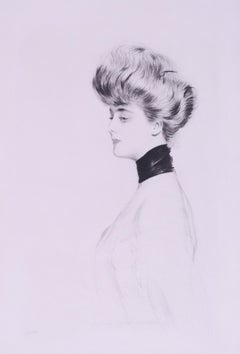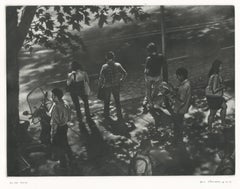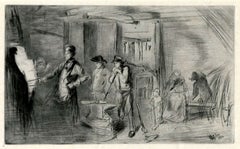Want more images or videos?
Request additional images or videos from the seller
1 of 2
Cornelis CortHercules Supports the World on behalf of Atlas1500s
1500s
$1,200List Price
About the Item
- Creator:Cornelis Cort (1533 - 1578, Flemish)
- Creation Year:1500s
- Dimensions:Height: 11.38 in (28.91 cm)Width: 8.88 in (22.56 cm)
- Medium:
- Period:
- Condition:Mounted to 18th century album support sheet.
- Gallery Location:Fairlawn, OH
- Reference Number:Seller: FA95481stDibs: LU140587422
About the Seller
5.0
Recognized Seller
These prestigious sellers are industry leaders and represent the highest echelon for item quality and design.
Gold Seller
Premium sellers maintaining a 4.3+ rating and 24-hour response times
Established in 1978
1stDibs seller since 2013
830 sales on 1stDibs
Associations
International Fine Print Dealers Association
Authenticity Guarantee
In the unlikely event there’s an issue with an item’s authenticity, contact us within 1 year for a full refund. DetailsMoney-Back Guarantee
If your item is not as described, is damaged in transit, or does not arrive, contact us within 7 days for a full refund. Details24-Hour Cancellation
You have a 24-hour grace period in which to reconsider your purchase, with no questions asked.Vetted Professional Sellers
Our world-class sellers must adhere to strict standards for service and quality, maintaining the integrity of our listings.Price-Match Guarantee
If you find that a seller listed the same item for a lower price elsewhere, we’ll match it.Trusted Global Delivery
Our best-in-class carrier network provides specialized shipping options worldwide, including custom delivery.You May Also Like
Jorge Castillo - EROTIC COMPOSITION Etching on paper Spanish Surrealism
By Jorge Castillo
Located in Madrid, Madrid
Jorge Castillo - COMPOSICIÓN ERÓTICA (Erotic Composition)
Date of creation: 1977
Medium: Etching on paper
Edition: 75 + 20 E.A.
Size: 50 x 65,5 cm
Condition: In perfect conditions an...
Category
1970s Surrealist Figurative Prints
Materials
Engraving, Etching
$299 Sale Price
20% Off
H 19.69 in W 25.79 in
Jorge Castillo - MARIENZA EN DOMINGO Etching Spanish Surrealism Feminine
By Jorge Castillo
Located in Madrid, Madrid
Jorge Castillo - MARIENZA EN DOMINGO
Date of creation: 1972
Medium: Etching on paper
Edition: 150 + H.C.
Size: 56 x 70 cm
Condition: In perfect conditions and never framed
Observatio...
Category
1970s Surrealist Figurative Prints
Materials
Paper, Engraving, Etching
$416
H 22.05 in W 27.56 in
Arrest of Christ, Engraving, a. Karel van Mander, p. by Gheyn, Passion of Chris
Located in Greven, DE
The arrest of Christ; Judas embraces Christ as a group of soldiers apprehend Him; Christ places His hand on the fearful Malchus who sits on the ground holding a lamp; Peter grips his sword; one of the soldiers holds up a flaming torch; after Karel van Mander
The scene is out of a set of 13 engravings "Passion of Christ"
Engraving
Published by: Jacques de Gheyn...
Category
17th Century Northern Renaissance Figurative Prints
Materials
Engraving
$713 Sale Price
20% Off
H 13.59 in W 9.65 in
Heinrich Ulrich after Paul Mair, Guard of Emperor Rudolph, Soldier, Landsknecht
Located in Greven, DE
Heinrich Ulrich (aka Heinrich Ullrich) (fl.1567–1621)
“Soldier with Hellebarde”, 1598, out of the series, “The Guard of Emperor Rudolph” (aka “Old German Soldiers...
Category
16th Century Renaissance Figurative Prints
Materials
Engraving
Heinrich Ulrich after Paul Mair, Guard of Emperor Rudolph, Soldier, Landsknecht
Located in Greven, DE
Heinrich Ulrich (aka Heinrich Ullrich) (fl.1567–1621)
“Soldier with Hellebarde”, 1598, out of the series, “The Guard of Emperor Rudolph” (aka “Old German Soldiers...
Category
16th Century Renaissance Figurative Prints
Materials
Engraving
Maerten De Vos, Baptista Vrints, Christ Baptism, Engraving, Old Master
By Maerten De Vos
Located in Greven, DE
Maerten de Vos after
J Baptista Vrints
Baptism Scene
Engraving
Category
17th Century Renaissance Figurative Prints
Materials
Engraving
$475
H 5.75 in W 4.73 in
untitled, original
By Paul Colin
Located in Belgrade, MT
This piece is a limited edition, pencil signed by the artist on the print and in the plate. It is part of my private collection of artists from the School of Paris era. It is in very...
Category
Mid-20th Century Surrealist Figurative Prints
Materials
Engraving, Lithograph
Nature Morte Harvest scene
By Maurice Savin
Located in Belgrade, MT
This lithograph is part of my private collection. It is original and pencil signed an numbered by the artist.
It is one of a kind in black and white.
Category
Mid-20th Century Abstract Expressionist Landscape Prints
Materials
Engraving, Lithograph
"Shooting" after George Townley Stubbs
Located in GB
William Woollett (1735–1785)
William Woollett was one of the most accomplished British engravers of the 18th century, renowned for his technical precision and his ability to translate the subtleties of painting into the language of print. Born in Maidstone, Kent, Woollett trained under John Tinney in London and quickly established himself as a master of landscape and historical engraving.
He became particularly celebrated for his engravings after works by artists such as Richard Wilson, Claude Lorrain, and Benjamin West — notably The Death of General Wolfe (after West), which became one of the most famous British prints of its age. Woollett’s exceptional skill in combining line engraving with etching allowed him to reproduce painterly effects of light, texture, and atmosphere with remarkable delicacy.
Elected an Associate Engraver of the Royal Academy in 1775, Woollett elevated the status of printmaking to that of a fine art. His works, characterized by technical brilliance and tonal richness, remain benchmarks of 18th-century British engraving.
George Stubbs (1724–1806)
George Stubbs is regarded as one of Britain’s greatest animal painters, celebrated for his scientific observation, anatomical accuracy, and artistic sensitivity. Born in Liverpool, he studied anatomy independently, dissecting horses to understand their musculature and structure — research that culminated in his celebrated publication The Anatomy of the Horse (1766).
Stubbs’s paintings...
Category
Late 18th Century Academic Figurative Prints
Materials
Engraving
Apollo Emerging from the Waters
By Simon Thomassin
Located in Houston, TX
Antique engraving titled "Apollon Sortant Des Eaux" over 250 years old by Simon Henri Thomassin, circa 1720. Signed lower right.
Original artwork on paper displayed on a white ma...
Category
1720s Figurative Prints
Materials
Engraving
More From This Seller
View AllPortrait de femme en buste, de profil a gauche, un tres large ruban noir du cou
By Paul César Helleu
Located in Fairlawn, OH
Portrait de femme en buste, de profil a gauche, un tres large ruban noir du cou, Mme Marthe Letellier
Drypoint, 1900-1901
Signed in pencil lower left (see photo)
Titled in pencil low...
Category
Early 1900s Impressionist Figurative Prints
Materials
Drypoint
As We Were
By Art Werger
Located in Fairlawn, OH
As We Were
Mezzotint printed on Hannemuelle Copperplate paper, 2014
Signed and dated in pencil lower right (see photo)
Titled lower left (see photo)
Chop stamp of the publisher, The ...
Category
2010s Contemporary Figurative Prints
Materials
Mezzotint
The Forge
By James Abbott McNeill Whistler
Located in Fairlawn, OH
The Forge
Drypoint, 1861
Signed in the plate lower right (see photo)
Published as part of the Thames Set, 1871
Printed between 1894 and 1896 when the plate was canceled. This impress...
Category
1860s Impressionist Figurative Prints
Materials
Drypoint
The Web
By Ray H. French
Located in Fairlawn, OH
The Web
Engraving and soft ground, 1950
Signed, titled, dated and numbered by the artist
Edition: 35 (26/35)
Printed by Master Printer, Jon Clemens, 2000
Provenance:
Estate of the ar...
Category
1950s Surrealist Figurative Prints
Materials
Engraving, Etching
Woman's Head (Vrouwekop), Marguerite Adolphine Helfrich
By Jan Toorop
Located in Fairlawn, OH
Woman's Head (Vrouwekop), Marguerite Adolphine Helfrich
Drypoint, 1897
Signed lower right in pencil: J Toorop; by later hand
Toorop's model for this print was Marguerite Adolphine H...
Category
1890s Jugendstil Figurative Prints
Materials
Drypoint
La Promenade
By Edgar Chahine
Located in Fairlawn, OH
La Promenade
Etching, soft-ground, aquatint & drypoint,
Signed in pencil lower left
Published by Edmund Sagot, Paris
Edition of 50 in black only, aside from the edition of 50 in co...
Category
Early 1900s Art Nouveau Figurative Prints
Materials
Drypoint, Etching, Aquatint



